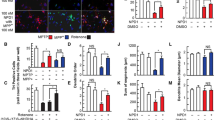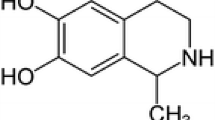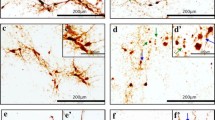Abstract
Among various types of neurons affected in Parkinson’s disease, dopamine (DA) neurons of the substantia nigra undergo the most pronounced degeneration. Products of DA oxidation and consequent cellular damage have been hypothesized to contribute to neuronal death. To examine whether elevated intracellular DA will selectively predispose the dopaminergic subpopulation of nigral neurons to damage by an oxidative insult, we first cultured rat primary mesencephalic cells in the presence of rotenone to elevate reactive oxygen species. Although MAP2+ neurons were more sensitive to rotenone-induced toxicity than type 1 astrocytes, rotenone affected equally both DA (TH+) neurons and MAP2+ neurons. In contrast, when intracellular DA concentration was elevated, DA neurons became selectively sensitized to rotenone. Raising intracellular DA levels in primary DA neurons resulted in dopaminergic neuron death in the presence of subtoxic concentrations of rotenone. Furthermore, mitochondrial superoxide dismutase mimetic, manganese (III) meso-tetrakis (4-benzoic acid) porphyrin, blocked activation of caspase-3, and consequent cell death. Our results demonstrate that an inhibitor of mitochondrial complex I and increased cytosolic DA may cooperatively lead to conditions of elevated oxidative stress and thereby promote selective demise of dopaminergic neurons.









Similar content being viewed by others
References
Warner DS, Sheng H, Batinic-Haberle I (2004) Oxidants, antioxidants and the ischemic brain. J Exp Biol 207:3221–3231
Jenner P, Olanow CW (1996) Oxidative stress and the pathogenesis of Parkinson’s disease. Neurology 47:S161–S170
Sossi V, Fuente-Fernandez R, Holden JE, Doudet DJ, McKenzie J, Stoessl AJ, Ruth TJ (2002) Increase in dopamine turnover occurs early in Parkinson’s disease: evidence from a new modeling approach to PET 18F-fluorodopa data. J Cereb Blood Flow Metab 22:232–239
Spina MB, Cohen G (1989) Dopamine turnover and glutathione oxidation: implications for Parkinson disease. Proc Natl Acad Sci USA 86:1398–1400
Graham DG (1978) Oxidative pathways for catecholamines in the genesis of neuromelanin and cytotoxic quinones. Mol Pharmacol 14:633–643
Sulzer D, Zecca L (2000) Intraneuronal dopamine-quinone synthesis: a review. Neurotox Res 1:181–195
Mizuno Y, Ohta S, Tanaka M, Takamiya S, Suzuki K, Sato T, Oya H, Ozawa T, Kagawa Y (1989) Deficiencies in complex I subunits of the respiratory chain in Parkinson’s disease. Biochem Biophys Res Commun 163:1450–1455
Schapira AH, Cooper JM, Dexter D, Clark JB, Jenner P, Marsden CD (1990) Mitochondrial complex I deficiency in Parkinson’s disease. J Neurochem 54:823–827
Janetzky B, Hauck S, Youdim MB, Riederer P, Jellinger K, Pantucek F, Zochling R, Boissl KW, Reichmann H (1994) Unaltered aconitase activity, but decreased complex I activity in substantia nigra pars compacta of patients with Parkinson’s disease. Neurosci Lett 169:126–128
Betarbet R, Sherer TB, MacKenzie G, Garcia-Osuna M, Panov AV, Greenamyre JT (2000) Chronic systemic pesticide exposure reproduces features of Parkinson’s disease. Nat Neurosci 3:1301–1306
Thiffault C, Langston JW, Di Monte DA (2000) Increased striatal dopamine turnover following acute administration of rotenone to mice. Brain Res 885:283–288
Dunnett SB, Boulton AA, Baker GB (2000) Neural transplantation methods. Humana Press, Totowa
Szabo C, Day BJ, Salzman AL (1996) Evaluation of the relative contribution of nitric oxide and peroxynitrite to the suppression of mitochondrial respiration in immunostimulated macrophages using a manganese mesoporphyrin superoxide dismutase mimetic and peroxynitrite scavenger. FEBS Lett 381:82–86
Ahmadi FA, Linseman DA, Grammatopoulos TN, Jones SM, Bouchard RJ, Freed CR, Heidenreich KA, Zawada WM (2003) The pesticide rotenone induces caspase-3-mediated apoptosis in ventral mesencephalic dopaminergic neurons. J Neurochem 87:914–921
Sherer TB, Kim JH, Betarbet R, Greenamyre JT (2003) Subcutaneous rotenone exposure causes highly selective dopaminergic degeneration and alpha-synuclein aggregation. Exp Neurol 179:9–16
Liu Y, Edwards RH (1997) The role of vesicular transport proteins in synaptic transmission and neural degeneration. Annu Rev Neurosci 20:125–156
Sipos I, Tretter L, Adam-Vizi V (2003) Quantitative relationship between inhibition of respiratory complexes and formation of reactive oxygen species in isolated nerve terminals. J Neurochem 84:112–118
Thornberry NA, Lazebnik Y (1998) Caspases: enemies within. Science 281:1312–1316
Rajput AH, Uitti RJ, Stern W, Laverty W, O’Donnell K, O’Donnell D, Yuen WK, Dua A (1987) Geography, drinking water chemistry, pesticides and herbicides and the etiology of Parkinson’s disease. Can J Neurol Sci 14:414–418
Ritz B, Yu F (2000) Parkinson’s disease mortality and pesticide exposure in California 1984–1994. Int J Epidemiol 29:323–329
Thiruchelvam M, Richfield EK, Baggs RB, Tank AW, Cory-Slechta DA (2000) The nigrostriatal dopaminergic system as a preferential target of repeated exposures to combined paraquat and maneb: implications for Parkinson’s disease. J Neurosci 20:9207–9214
Bindoff LA, Birch-Machin M, Cartlidge NE, Parker WD Jr, Turnbull DM (1989) Mitochondrial function in Parkinson’s disease. Lancet 2:49
Parker WD Jr, Boyson SJ, Parks JK (1989) Abnormalities of the electron transport chain in idiopathic Parkinson’s disease. Ann Neurol 26:719–723
Bindoff LA, Birch-Machin MA, Cartlidge NE, Parker WD Jr, Turnbull DM (1991) Respiratory chain abnormalities in skeletal muscle from patients with Parkinson’s disease. J Neurol Sci 104:203–208
Tatton WG, Chalmers-Redman R, Brown D, Tatton N (2003) Apoptosis in Parkinson’s disease: signals for neuronal degradation. Ann Neurol 53(Suppl 3):S61–S70
Obata T (2002) Role of hydroxyl radical formation in neurotoxicity as revealed by in vivo free radical trapping. Toxicol Lett 132:83–93
Lee SY, Moon Y, Hee CD, Jin CH, Hwang O (2006) Particular vulnerability of rat mesencephalic dopaminergic neurons to tetrahydrobiopterin: relevance to Parkinson’s disease. Neurobiol Dis 25:112–120
Mosharov EV, Staal RG, Bove J, Prou D, Hananiya A, Markov D, Poulsen N, Larsen KE, Moore CM, Troyer MD, Edwards RH, Przedborski S, Sulzer D (2006) Alpha-synuclein overexpression increases cytosolic catecholamine concentration. J Neurosci 26:9304–9311
Mazzulli JR, Mishizen AJ, Giasson BI, Lynch DR, Thomas SA, Nakashima A, Nagatsu T, Ota A, Ischiropoulos H (2006) Cytosolic catechols inhibit alpha-synuclein aggregation and facilitate the formation of intracellular soluble oligomeric intermediates. J Neurosci 26:10068–10078
Hasbani DM, Perez FA, Palmiter RD, O’Malley KL (2005) Dopamine depletion does not protect against acute 1-methyl-4-phenyl-1,2,3,6-tetrahydropyridine toxicity in vivo. J Neurosci 25:9428–9433
Talpade DJ, Greene JG, Higgins DS Jr, Greenamyre JT (2000) In vivo labeling of mitochondrial complex I (NADH:ubiquinone oxidoreductase) in rat brain using [(3)H]dihydrorotenone. J Neurochem 75:2611–2621
Verstreken P, Ly CV, Venken KJ, Koh TW, Zhou Y, Bellen HJ (2005) Synaptic mitochondria are critical for mobilization of reserve pool vesicles at Drosophila neuromuscular junctions. Neuron 47:365–378
Chee F, Mudher A, Newman TA, Cuttle M, Lovestone S, Shepherd D (2006) Overexpression of tau results in defective synaptic transmission in Drosophila neuromuscular junctions. Biochem Soc Trans 34:88–90
Hirsch EC, Hoglinger G, Rousselet E, Breidert T, Parain K, Feger J, Ruberg M, Prigent A, Cohen-Salmon C, Launay JM (2003) Animal models of Parkinson’s disease in rodents induced by toxins: an update. J Neural Transm Suppl 65:89–100
Zeevalk GD, Bernard LP (2005) Energy status, ubiquitin proteasomal function, and oxidative stress during chronic and acute complex I inhibition with rotenone in mesencephalic cultures. Antioxid Redox Signal 7:662–672
Madhavan L, Ourednik V, Ourednik J (2006) Increased “vigilance” of antioxidant mechanisms in neural stem cells potentiates their capability to resist oxidative stress. Stem Cells 24:2110–2119
Dukes AA, Korwek KM, Hastings TG (2005) The effect of endogenous dopamine in rotenone-induced toxicity in PC12 cells. Antioxid Redox Signal 7:630–638
Liu HQ, Zhu XZ, Weng EQ (2005) Intracellular dopamine oxidation mediates rotenone-induced apoptosis in PC12 cells. Acta Pharmacol Sin 26:17–26
Sakka N, Sawada H, Izumi Y, Kume T, Katsuki H, Kaneko S, Shimohama S, Akaike A (2003) Dopamine is involved in selectivity of dopaminergic neuronal death by rotenone. Neuroreport 14:2425–2428
Santiago M, Granero L, Machado A, Cano J (1995) Complex I inhibitor effect on the nigral and striatal release of dopamine in the presence and absence of nomifensine. Eur J Pharmacol 280:251–256
Bashkatova V, Alam M, Vanin A, Schmidt WJ (2004) Chronic administration of rotenone increases levels of nitric oxide and lipid peroxidation products in rat brain. Exp Neurol 186:235–241
Segura-Aguilar J, Lind C (1989) On the mechanism of the Mn3(+)-induced neurotoxicity of dopamine:prevention of quinone-derived oxygen toxicity by DT diaphorase and superoxide dismutase. Chem Biol Interact 72:309–324
Daveu C, Servy C, Dendane M, Marin P, Ducrocq C (1997) Oxidation and nitration of catecholamines by nitrogen oxides derived from nitric oxide. Nitric Oxide 1:234–243
Terland O, Flatmark T, Tangeras A, Gronberg M (1997) Dopamine oxidation generates an oxidative stress mediated by dopamine semiquinone and unrelated to reactive oxygen species. J Mol Cell Cardiol 29:1731–1738
Seaton TA, Cooper JM, Schapira AH (1997) Free radical scavengers protect dopaminergic cell lines from apoptosis induced by complex I inhibitors. Brain Res 777:110–118
Molina-Jimenez MF, Sanchez-Reus MI, Benedi J (2003) Effect of fraxetin and myricetin on rotenone-induced cytotoxicity in SH-SY5Y cells: comparison with N-acetylcysteine. Eur J Pharmacol 472:81–87
Molina-Jimenez MF, Sanchez-Reus MI, Andres D, Cascales M, Benedi J (2004) Neuroprotective effect of fraxetin and myricetin against rotenone-induced apoptosis in neuroblastoma cells. Brain Res 1009:9–16
Packer MA, Miesel R, Murphy MP (1996) Exposure to the parkinsonian neurotoxin 1-methyl-4-phenylpyridinium (MPP+) and nitric oxide simultaneously causes cyclosporin A-sensitive mitochondrial calcium efflux and depolarisation. Biochem Pharmacol 51:267–273
He Y, Imam SZ, Dong Z, Jankovic J, Ali SF, Appel SH, Le W (2003) Role of nitric oxide in rotenone-induced nigro-striatal injury. J Neurochem 86:1338–1345
Lin KT, Xue JY, Lin MC, Spokas EG, Sun FF, Wong PY (1998) Peroxynitrite induces apoptosis of HL-60 cells by activation of a caspase-3 family protease. Am J Physiol 274:C855–C860
Viriag L, Scott GS, Cuzzocrea S, Marmer D, Salzman AL, Szabo C (1998) Peroxynitrite-induced thymocyte apoptosis: the role of caspases and poly (ADP-ribose) synthetase (PARS) activation. Immunology 94:345–355
Bolanos JP, Peuchen S, Heales SJ, Land JM, Clark JB (1994) Nitric oxide-mediated inhibition of the mitochondrial respiratory chain in cultured astrocytes. J Neurochem 63:910–916
Cassina A, Radi R (1996) Differential inhibitory action of nitric oxide and peroxynitrite on mitochondrial electron transport. Arch Biochem Biophys 328:309–316
LaVoie MJ, Hastings TG (1999) Dopamine quinone formation and protein modification associated with the striatal neurotoxicity of methamphetamine: evidence against a role for extracellular dopamine. J Neurosci 19:1484–1491
LaVoie MJ, Hastings TG (1999) Peroxynitrite- and nitrite-induced oxidation of dopamine: implications for nitric oxide in dopaminergic cell loss. J Neurochem 73:2546–2554
Imam SZ, Newport GD, Itzhak Y, Cadet JL, Islam F, Slikker W Jr, Ali SF (2001) Peroxynitrite plays a role in methamphetamine-induced dopaminergic neurotoxicity: evidence from mice lacking neuronal nitric oxide synthase gene or overexpressing copper-zinc superoxide dismutase. J Neurochem 76:745–749
Ara J, Przedborski S, Naini AB, Jackson-Lewis V, Trifiletti RR, Horwitz J, Ischiropoulos H (1998) Inactivation of tyrosine hydroxylase by nitration following exposure to peroxynitrite and 1-methyl-4-phenyl-1,2,3,6-tetrahydropyridine (MPTP). Proc Natl Acad Sci USA 95:7659–7663
Schulz JB, Matthews RT, Muqit MM, Browne SE, Beal MF (1995) Inhibition of neuronal nitric oxide synthase by 7-nitroindazole protects against MPTP-induced neurotoxicity in mice. J Neurochem 64:936–939
Hantraye P, Brouillet E, Ferrante R, Palfi S, Dolan R, Matthews RT, Beal MF (1996) Inhibition of neuronal nitric oxide synthase prevents MPTP-induced parkinsonism in baboons. Nat Med 2:1017–1021
Boireau A, Dubedat P, Bordier F, Imperato A, Moussaoui S (2000) The protective effect of riluzole in the MPTP model of Parkinson’s disease in mice is not due to a decrease in MPP(+) accumulation. Neuropharmacology 39:1016–1020
Yamada T, McGeer PL, Baimbridge KG, McGeer EG (1990) Relative sparing in Parkinson’s disease of substantia nigra dopamine neurons containing calbindin-D28K. Brain Res 526:303–307
German DC, Manaye KF, Sonsalla PK, Brooks BA (1992) Midbrain dopaminergic cell loss in Parkinson’s disease and MPTP-induced parkinsonism: sparing of calbindin-D28k-containing cells. Ann N Y Acad Sci 648:42–62
Meyer M, Zimmer J, Seiler RW, Widmer HR (1999) GDNF increases the density of cells containing calbindin but not of cells containing calretinin in cultured rat and human fetal nigral tissue. Cell Transplant 8:25–36
Acknowledgments
This research was supported by National Institutes of Health grants NINDS NS 38619 and NIAAA U01 AA13473 (Integrated Neuroscience Initiative on Alcoholism, INIA West Consortium). The authors thank Dr Curt Freed for scientific suggestions, Dr Kimberly Bjugstad for help with the statistical analysis, Dr Nancy Zahniser and Dr Susane Doolen for dopamine uptake analysis, Cindy Hutt for technical assistance, and Peggy Borgese from Hoffman-La Roche Inc. for providing tetrabenazine.
Author information
Authors and Affiliations
Corresponding author
Rights and permissions
About this article
Cite this article
Ahmadi, F.A., Grammatopoulos, T.N., Poczobutt, A.M. et al. Dopamine Selectively Sensitizes Dopaminergic Neurons to Rotenone-Induced Apoptosis. Neurochem Res 33, 886–901 (2008). https://doi.org/10.1007/s11064-007-9532-5
Received:
Accepted:
Published:
Issue Date:
DOI: https://doi.org/10.1007/s11064-007-9532-5




